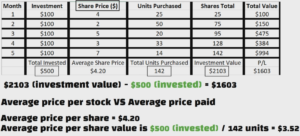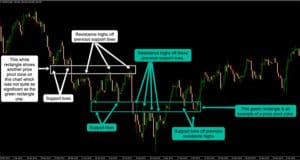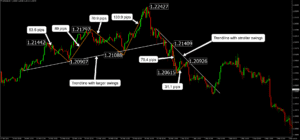Financial advisors believe that regular investing is vital to achieving great financial success, however, timing market movements is risky and often unsuccessful.
That’s where dollar cost averaging comes in.
Imagine if professional analysts predict a massive recession is coming soon.
Should you save money and hold tight? Or would you be better off investing smaller amounts over time?
These questions help us understand if dollar cost averaging is beneficial. Dollar-cost averaging means investing a consistent amount in an asset over a period.
A common example of dollar-cost averaging is a typical 401k plan, as investments are usually made automatically over a pre-planned schedule. Dollar-cost averaging is also often used for other investments such as index funds, ETF’s or mutual funds.
How dollar cost averaging works
Simply put, it involves investing a fixed amount in an asset over a period of time. Regardless of whether an investment price increases or decreases, you continue buying with a fixed amount on a schedule.
Automating investments requires very little work once set up; however, not automating them is more complicated and time-consuming and may leave you a greater chance of being influenced by market fluctuations.
If you choose automated or manual, the technique remains the same. You invest the same amount regularly regardless of the price.
Automating can reduce the chance of panic during market crashes and becomes volatile. Newer investors will often miss opportunities to benefit from discounted stock prices after market downturns unless they automate the process.
Legendary investors like Warren Buffett have been known for being greedy when others are fearful during times of crisis to find greater value in the market. When prices fall, investors often become afraid and buy less, but much of the opportunity to find value is during these periods.
Dollar-cost averaging can help limit negative emotions and increase the chance of profiting over volatile market periods. Buying more over a market crash reduces the average cost per share.
Additionally, the opposite benefit can occur during a market rally as overconfidence can run high, causing investors to buy soon before a crash.
Fear of missing out during times of high confidence can be challenging for investors not to feel tempted into buying. Also, investment experts in the media can influence investors as they often have very different forecasts regarding the next recession.
Let’s look at an example to help you understand dollar cost averaging. Say you put $100 into a stock over five consecutive months. Prices change; therefore you’ll get a different number of stocks every time $100 is invested, as shown by the diagram. 
The total amount invested is $500. In the end, 142 units were bought, and the total value of the stocks is $2103. If we do $2103 minus $500, we get a profit of $1603. Understanding the average price for each stock versus the average price paid is critical. The average price you paid for each share at the end was $4.20. But the average price per share is $500 divided by 142 units which is just $3.52.
As you can see from the example, a good return was achieved by consistently investing over time, although that’s not always the case.
Key advantages and disadvantages
Let’s begin with the main disadvantages before moving on to the advantages. It’s worth noting that dollar cost averaging will usually decrease risk but it’s also less likely to result in greater returns.
Over the long run, stock markets rise, so investing a more significant sum sooner will likely outperform a smaller sum spread out over time. Because of the rising stock market, the lump sum investment should usually deliver a larger long-term return. However, if the lump sum were invested soon before a crash, it would likely perform worse than dollar cost averaging into the market.
According to a Vanguard study examining the returns of lump sum versus cost-averaging, it turned out that lump sum investing produces a greater result 68% of the time.
The study compared the performance of three portfolios: 100% equity, 60% stocks with 40% bonds and 40% stocks with 60% bonds. The investment was $100,000 over one year. Overall, the study found that the longer the period, the greater the performance of lump sum investing was over cost averaging.
Dollar-cost averaging is particularly useful when investing in volatile markets as it can help reduce your emotions regarding decisions around difficult times. However, if a market rises fast, those using dollar cost averaging will usually buy less and, as a result, miss out on much of the gain. Also, if a market declines, they’ll continue purchasing more when they shouldn’t.
Using this strategy does not mean you can ignore market research and simply automate all investments. The reason is that an investor must continue buying when sometimes it doesn’t make sense, which obviously results in weaker returns.
Also, be aware that dollar cost averaging means repeated investing; therefore it’ll often result in larger transaction fees than investing more significant sums less frequently.
An advantage of dollar-cost averaging is reducing the potential for negative emotions to impact our investment decisions. During market fluctuations, we’re particularly vulnerable to negative emotions that can quickly build up and lead to poor choices.
In addition, when compared to a lump payment method, it helps reduce the risk of bad investment timing. The technique can act like a drawdown insurance policy as it helps against investing a large amount just before a market crash. Investing gradually is less risky as it’s not possible to forecast market movements with absolute certainty.
A benefit of automatic investing on a fixed plan is that it helps relieve the pressure of making decisions, especially when a market is volatile. Automatic investing is highly beneficial for people who are nervous or anxious during market fluctuations.
It’s suitable for new investors needing more experience or skill to determine the best times to invest. It can be particularly useful for beginner investors as it can help them continue buying during market declines when shares can be at a discount.
However, if a beginner chooses a lump sum investment approach, they will likely buy during a market rally and experience a significant drawdown soon after. This means most beginner investors will probably have a lower average share price using dollar cost averaging compared to lump sum investing.
Dollar-cost averaging is simple yet highly effective. Reducing emotional highs and lows by systematically investing a fixed amount each period can be particularly beneficial for less experienced investors.
I think it’s a good idea to consider dollar cost averaging as investing regularly and maintaining discipline are key to long-term financial success. If you enjoyed reading this make sure you check out more content from the blog.






